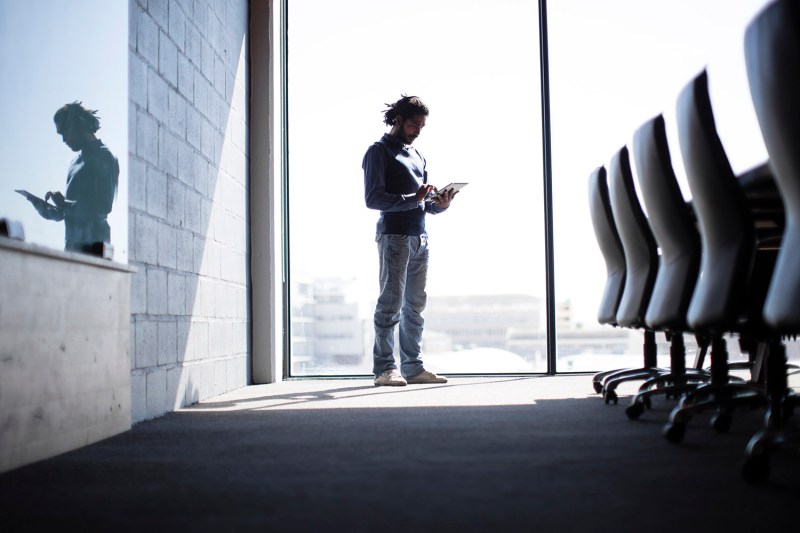Mustaches are awesome. There’s really no arguing with that. Whether worn pencil-thin, as a handlebar, or waxed and wide, there’s no style of mustache that isn’t just a wonderful thing. (Well, OK, maybe one style that lost popularity in the mid-1940s.) So sublime is the mustache that it even has an entire month devoted: Movember.
But just as the real article is the man behind the mustache, the real story of Movember isn’t about the ‘stache, it’s about how the man behind that hirsute lip is doing, both in terms of physical and mental health. It’s about giving gentlemen a hand when they’re not doing so great and making it OK to talk about struggles.
Put simply, Movember is not about mustaches, it’s about more openly addressing challenges many men face. According to Movember, official foundation of the movement many men find it a serious issue to talk about their issues, and nowhere is this more prevalent than in the workplace.

According to studies conducted jointly by Movember and Ipsos MORI, 34% of men in America feel their jobs would be at risk if they talked about their mental health challenges at work and 36% think they would be prevented from getting a promotion at work if they mentioned a problem they were finding it difficult to cope with. And if you’ll pardon the double negative, we’re not not talking about petty stuff. The goal of Movember is to tackle “prostate cancer, testicular cancer, mental health, and suicide prevention.” None of those are issues a man should have to grapple with alone, but far too often that’s exactly what happens.
Movember is working to detoxify male-centric workplace culture and to get men both in and out of the office more comfortable talking about their issues. A recent report from the foundation found, among other conclusions, that:
- Most men see themselves as being manly/masculine and believe masculinity is about being strong both physically and emotionally. Three-quarters of men describe themselves as being manly/masculine (75%) and nearly half describe masculinity in terms of being strong (48%).
- Men see advantages of being manly/masculine such as helping them to get a partner (57%), deal with day to day life (50%) and getting or keeping a job (49%).
- Men think that society expects them to be emotionally strong and not show weakness (58% think this)
- A substantial proportion of men (38%) have avoided talking to others about how they feel in order to avoid appearing unmanly.
- Many men wish that they could talk more to others about personal problems they have experienced(43%).
- Most men believe that talking can help. Over three-quarters of men (77%) think that talking is an effective way to deal with problems, and 76% believe that talking openly can have a positive impact on mental health.
For more insight, we talked to Susan Todd, Movember’s U.S. Director of Mental Health and Suicide Prevention, and Mark Hedstrom, the U.S. Executive Director.
The Manual: What has gone wrong with the way the stereotypical sense of masculinity has developed, and what can we do about it? What should be the new paradigm of manliness?
Susan Todd: Centuries of telling men “how they should be” has created a culture of promoting behavior that puts them at risk, one where men aren’t seeking help when they need it. We support breaking down male stereotypes that negatively impact men’s health. It’s important to focus on healthy masculinity which emphasizes the strengths, emotions, and virtues of men. We want men to focus on parts of themselves that are good, creative, successful, kind, and capable, while not being limited by societal stereotypes.
TM: What challenges do men unfairly face in the workplace?
Mark Hedstrom: Gender parity at the workplace is a very important issue that needs to be addressed. A recent Harvard Business Review article titled “What most people get wrong about men and women” has some great points: “Science, by and large, does not actually support the claim that men and women are fundamentally different, by virtue of their genes or their upbringing or both.”
While there are differences, they are not ingrained in fixed gender traits. The difference between men and women in the workplace comes from organizational structures, company practices, and situations.
It’s important to focus on healthy masculinity which emphasizes the strengths, emotions, and virtues of men. [Movember wants] men to focus on parts of themselves that are good, creative, successful, kind, and capable, while not being limited by societal stereotypes.
Parenting is an interesting example as workplaces should do more to better support fathers. The majority of U.S. employers offer minimal leave opportunities for mothers and relatively no leave opportunities for fathers. According to a Department of Labor study, only 13% of men who took parental leave received pay compared with 21 percent for women. When at work, mothers (but not fathers) are seen as needing support, whereas men don’t always get the same support. They are more likely to be told either directly or indirectly to “man up.” For example, if men do request a lighter travel schedule, while their supervisors might agree, it is frequently reluctantly and with the clear expectation that it is temporary.
TM: How was Movember started? How did the official organization grow out of the original movement?
MH: Movember started in 2003 in Australia when two friends wanted to bring the mustache back and make it fashionable while also raising awareness about men’s health. Many years later through mustaches grown, connections created, and conversations generated, Movember has proudly welcomed over 6 million supporters and helped fund 1,250 innovative men’s health projects across 20 countries. But there is still plenty more to be done.

TM: What are the primary goals of the foundation?
ST: The charity recognizes that globally, men are dying six years earlier than women due to common health issues such as prostate cancer, testicular cancer, mental health, and suicide. Movember is aiming to reduce the number of men dying too young by 25% by 2030.
TM: What can men (and women) do to support Movember, mustaches included in, but also beyond?
ST: There are many ways to get involved!
- Grow a mustache.
- Move and commit to walking or running 60 miles over the month. That’s 60 miles for the 60 men we lose each hour, every hour, to suicide across the world.
- Host an event. Get together with friends and family. Cook up a dinner. Host a shave-down. Do it your way.
- Donate now at movember.com.
TM: Who are the Mo Bros and how does one become a Bro?
MH: Our Mo Bros and Mo Sisters are our ambassadors across the world who fundraise and continue to help raise awareness about men’s health. Anyone can become a Mo Bro or Mo Sister by signing up at movember.com
You can join The Manual’s Movember team here.


